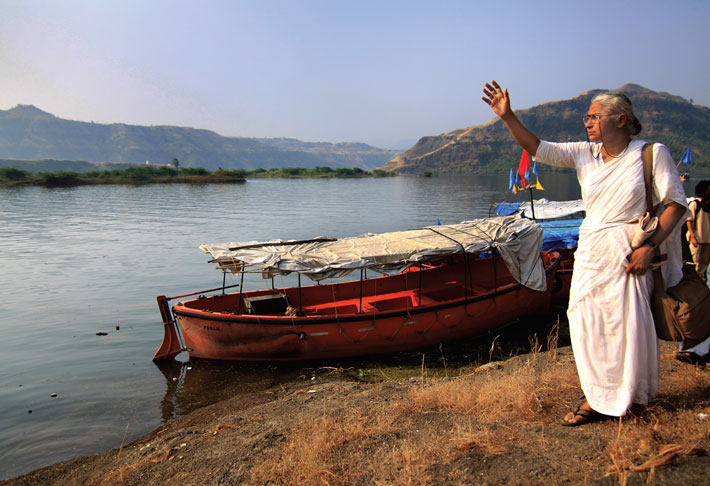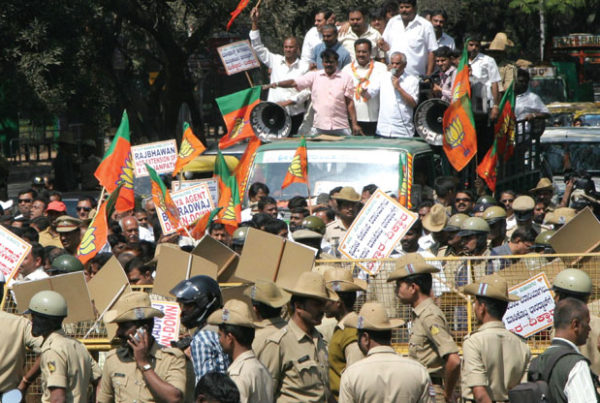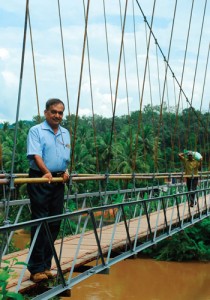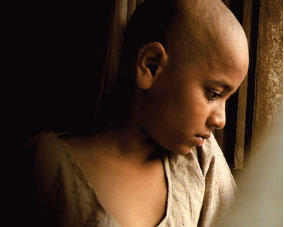State apathy hasn’t killed the Medha Patkar-led Narmada Bachao Andolan. Sanjana Chappalli discovers that 25 years later, it still inspires and galvanises similar struggles for justice across India
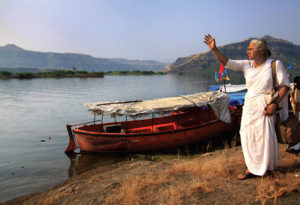 Photos: Shailendra Pandey
Photos: Shailendra PandeyA group of 12 boys encircle three in the centre – one wears a ghoulish mask and carries a bow and arrow; another is riding a toy horse while the third is dressed as a girl. Drum beats accompany the Adivasi boys as they make their way through the motley crowd gathered in Dhadgaon, Maharashtra. It has been 25 years since the Narmada Bachao Andolan – a people’s movement that has brought the struggle in the Narmada valley to the fore – started.
The boys’ colourful headgears, the bells tied securely around their waist and anklets, a string of dry gourds and plastic bottles strung around their slim shoulders and the painted faces are enough for the cameras to surface. As people whip out their mobiles for that one shot at memory, there is no change in the boys’ pace or expression. But it is really the interactions between the three boys in the centre that are most instructive. It is a searing reflection of the ongoing struggle in the Narmada valley – the girl and the boy on the horse dance defiantly in front of the ghoul, ignoring his repeated aims to shoot them down with his bow and arrow. For at least 25 years now, unmindful of the State’s frequently violent postures, the people in the valley have stuck to their rhythm. Danced in front of policemen wielding lathis and guns and raised slogans as they raised their batons. Adivasis, peasants, landless labourers, fish-workers from the valley have walked streets in protest only to watch government after government walk away, refusing to meet their gaze or answer their questions. On 22-23 October, people gathered in Dhadgaon, about 380 km from Mumbai, to remember the streets they have walked in protest. And to remind themselves of the injustice that continues to unravel in the Narmada valley.
For the uninitiated, Narmada is one of India’s longest rivers. Rising near Amarkantak in Madhya Pradesh, it flows westwards through Madhya Pradesh, Maharashtra and Gujarat before draining out into the Arabian Sea. In 1961, in step with his “dams are temples of modern India” mantra, Jawaharlal Nehru, India’s first prime minister, laid the foundation stone for the Sardar Sarovar Project (SSP), the largest dam in a series of 30 large dams, 135 medium dams and 3000 small dams planned on the river Narmada. The dams, collectively termed the Narmada Valley Development Project, were the government’s attempt to harness water that was otherwise, in their opinion, flowing out wastefully into the sea. It was possible, the project conceivers argued, to deliver water to drought-prone areas hundreds of kilometers away from the river, irrigate agricultural fields and electrify villages in the three states – if the SSP and the project as a whole was implemented.
While protests and questions from the estimated 2.5 crore people living have always taken place, the formation of the Narmada Bachao Andolan in 1985 gave the protests much-needed momentum. Among the team of social science researchers and social workers who came to the valley to study the impact of dams, was then 31-year-old Medha Patkar – one of the founders of the NBA. An unstoppable force of energy, Medha has over the years become synonymous with the Narmada Bachao Andolan. Instrumental in charting the course of the NBA and in channeling much of its energy, Medha is today a familiar face across people’s movements in India. From Nandigram in West Bengal to Nandagudi in Karnataka, she has travelled across the country to raise her voice in protest along with hundreds of others. While criticisms surface about Medha’s constant presence in the media, on the ground, it is impossible to deny that her presence alone at times has galvanised much needed public attention.
Staunchly Gandhian in its ideology, the NBA has firmly held on to its strategy of non-violence even in the face of extreme provocation. A fundamental question that the NBA has raised has been about the financial costs incurred by the State on huge development projects such as the SSP and the social costs incurred by ordinary people for the sake of a privileged few. Inherent in these questions have been the role of the state as it unequivocally alters the lives and livelihoods of lakhs of people through its persistent and seemingly blind facilitation of this unequal cost-benefit balance.
By any stretch, this is a simplistic, dumbed-down version of the NBA’s trajectory over the past 25 years. It says nothing of the methods adopted to raise these questions – the jal satyagrahas, dharnas, hunger fasts, rasta rokos, rallies. Or the several milestones. The 50,000 people who gathered in Harsud, Madhya Pradesh in September 1989 to raise the slogan of vikas chahiye, vinas nahin (we want development, not destruction). Months later, inspired by the movement, Baba Amte, a miracle worker in his own right, decided to join the struggle and settle down on the banks of the river. The much-lamented July 1993Jal Samarpan (sacrifice by drowning in the Narmada river). The 1993 victory rally as the World Bank decided to withdraw from the project. The July 1999 ‘Rally for the Valley’ cry – the launch of satyagraha against submergence in Domkhedi and Jalsindhi – two villages that emerged as the epicentres of the struggle. The stillness that set in when the Supreme Court in October 2000 dismissed the NBA petition and ordered the construction of the SSP to its full height. The 21-day hunger-fast in Delhi in April 2006 by Medha and seven others. And several thousand other rallies and protest marches as the NBA took on gram panchayats, district collectors, the state and central governments. The World Bank even.
But even these say nothing of the imaginations that the NBA has triggered over the years. Fired by stories of the struggle, thousands of people have consistently arrived in the valley from Montreal to Mangalore. And stayed. And left. And come back. I was 17 when I first landed in the Baroda office of the NBA. When a senior activist, who had by then spent 11 years with the struggle, asked why I was there, all I could muster was a feeble, “ want to know more”. And two days later, I walked into a meeting led by Medha in Domkhedi, an Adivasi village that was slated for submergence. I stayed on for seven weeks. And left. And returned three more times over the years. I was only of many thousands whose lives in the valley (and since) have been stamped indelibly by the NBA and its struggles. Friends who sit across their partners and talk shyly of meeting them at NBA rallies (“We were there for the Harsud rally… we couldn’t find him one night and I went looking for him”). Others who have sharp memories of relationships being triggered by letters sneaked from jails following an NBA protest (“The connect is strong because our political journeys began from the Valley”). Yet another who grew up in the NBA (“I was four when my father took me for the first rally”) and continues to live there. The simplicity of the questions that the NBA asked and the energy of the struggles that echoed in the valley touched people who lived there and those who visited; the political and the personal.
The flood of people who arrived at the valley soon earned them the label of ‘middle-class activists’ who were frequently under question. Would they stamp the struggle in the valley with their own ideological baggage? Impress and influence the Adivasis and the farmers – ‘the primary affected’ – who lived in the valley? Sitting in the tiny Badwani office of the NBA, I had broached this issue with Ashish Mandloi, an NBA activist and farmer in the Nimad region of Madhya Pradesh. Only to be faced by a fiery response. Ashishbhai had been affronted. “It isn’t merely an action of support. People come to work with us because they see themselves as part of the struggle. It is as much their responsibility to ask questions of the development paradigm that India is following as it is the compulsion of the Adivasis and the farmers who stood to lose if the dams were completed.” (Tragically, Ashishbhai died of a heart attack on 20 May this year. He was 38).
And yet we have to look beyond the imaginations that the struggle in the Narmada valley triggered if we have to understand why the NBA today occupies a seminal position in the political landscape of Indian movements. Since the movement began, the articulation of development politics in this country has been transformed. Says Himanshu Thakkar, a researcher with South Asia Network on Dams, Rivers and People and a former NBA activist, “The NBA changed the contours of the debate on the development politics in the country. It has had a lasting influence on the way rehabilitation has been viewed in this country.”
At a policy level too, the NBA’s influence is hard to ignore. The Environmental Sub-Group of the Narmada Valley Development Authority (a nodal agency set up by the Madhya Pradesh government “to oversee water resources development in the Narmada basin”) has been consistently monitoring the project in an unprecedented manner. While environment governance for most projects stops with the grant of the environmental clearance, in the case of the Narmada project, a legally empowered and independent sub group was set up to monitor the project at every level – no mean achievement in the bureaucratic wrangle that defines India.
Important as it is to recognise the influence exerted by the NBA, there are fundamental questions to be asked of the movement. Ideologically, the NBA has been almost adamantly Gandhian. At a time when India’s political sphere is punctured by debates triggered by the Maoist movement and their insistence on armed struggle (among other methods) as the path to achieve social and political change, how relevant is a movement that refuses to move away from the Gandhian path of ahimsa or non-violence? It is easy to notice that the State’s (the government, the judiciary and the police force) preoccupation with the Maoist movement far outweighs its response to an NBA hunger-fast.
‘THE NBA HAS HAD A LASTING INFLUENCE ON THE WAY REHABILITATION HAS BEEN VIEWED,’ SAYS RESEARCHER THAKKAR
Expectedly, the State’s response to the Maoist movement is a visibly violent one; but what of its continued apathy to the questions raised by the NBA through its non-violent methods? Does a continued ignorance or a blatant dismissal (the Supreme Court decision on 18 October 2000 dismissed the NBA’s petition and ordered the construction of the SSP to its full height of 138.68 m) indicate a failure of non-violence as a strategy to demand justice? “This is a question that should trigger serious introspection from the Indian State. By ignoring the demands for justice from the Narmada valley, what is the message they are putting out for other movements?” asks Swami Agnivesh, a social activist at the 22 October press conference organised by the NBA in the valley. Others are far less direct in their questions. “The nature of the state has changed,” Rakesh Dewan, a senior activist of the NBA. “For years, I have maintained that Gandhian methods such as hunger fasts have zero impact on the government. That we need to introspect and reflect on ways we can push forward our demands for justice.” Even within the Gandhian paradigm, there are endless possibilities – history bears testimony to Gandhi’s own ability to experiment with methods.
If 25 years of a movement is an important moment to consider the actions of the past and reflect on the way forward, it did not figure in the two days’ events in the valley. What we witnessed instead was an affirmation to continue on the path of struggle even as several movements from across the country vowed to join hands and confront the state under the united banner of the National Alliance of People’s Movements.
For every question that needs to be asked is a memory of the trail that the NBA has blazed in its 25 years. How can we not remember a young Adivasi girl who climbed a tree in a police station as the police attempted to arrest her? She had raised slogans against the dam for hours. How can we not remember the young boys who continue to dance defiantly even as the ghoul attempts to shoot them down?
—
This article was originally published in Tehelka, a leading independent news magazine in India, known for its investigative journalism.
